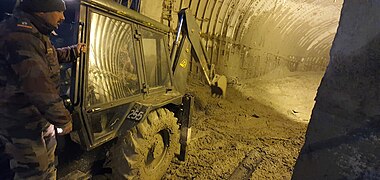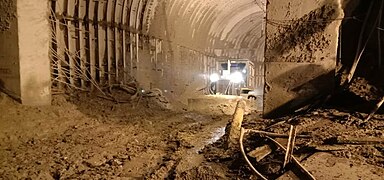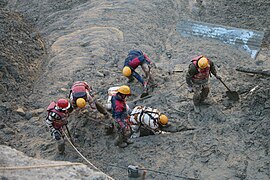2021 Uttarakhand flood
This article is about a current disaster where information can change quickly or be unreliable. The latest page updates may not reflect the most up-to-date information. |
 The state of Uttarakhand within India | |
| Date | 7 February 2021 |
|---|---|
| Location | Uttarakhand |
| Cause | Undetermined |
| Deaths | 31 dead, 165 missing, 18 rescued |
| Property damage | Not yet estimated |





The 2021 Uttarakhand flood began on 7 February 2021 in the environs of the Nanda Devi National Park, a UNESCO World Heritage Site[2] in the outer Garhwal Himalayas in Uttarakhand state, India.[3] It is believed to have been caused by a landslide, an avalanche or a glacial lake outburst flood.[4] It has caused flooding in the Chamoli district, most notably in the Rishiganga river, the Dhauliganga river, and in turn the Alaknanda—the major headstream of the Ganges.[5][6] At least 31 people are confirmed to have been killed and around 165 are missing.[7][8][9][10]
Background
Scientists have warned that climate change is melting the Himalayan glaciers at an alarming pace, more than twice on average than the 20th century. The glaciers, which supply water to a vast number of people, could be mostly gone by the end of the century. “This looks very much like a climate change event,” said Anjal Prakash, a professor at the Indian School of Business in Hyderabad who serves on a United Nations panel on climate change. “The glaciers are melting due to global warming.”[11][12][13][14]
Cause
The flooding was caused when a portion of the Nanda Devi glacier broke off early on 7 February, releasing the water trapped behind the ice in a glacial lake outburst flood.[15] The cause for the glacier falling apart may be due to climate change or as a result of construction projects in the area. The source, likely a proglacial lake dammed by glacial till that was deposited as the Himalayan glaciers retreat, could have been hidden beneath a layer of ice that masked it from satellite imaging.[16] Other scientists have noted that satellite images suggest it may have been a landslide that triggered events.[17][18]
Damage
The Rishiganga power project on the Rishiganga river, a tributary to the Dhauliganga River, was damaged and 35 laborers working on the project are missing.[19] The district of Chamoli in Uttarakhand appeared to have been hit hardest by the surging Dhauliganga River.[20] The Dhauliganga Dam at the confluence of the Rishiganga and Dhauliganga rivers (at 30°33′45″N 79°34′33″E / 30.56250°N 79.57583°E) was washed away by the floodwaters.[21][22] Chief Minister Trivendra Singh Rawat stated that flash floods also impacted a much larger hydro project owned by the NTPC with around 176 laborers working on a project which had two tunnels where those workers were trapped.[23] Senior police officials told media that a bridge in the Tapovan area that connected 13 villages was washed away in the avalanche.[24] Some experts have suggested reduced snowfall this winter may have played a part in the disaster.[25]
Among the places most severely hit by the floods are Joshimath, Chamoli district, Rini, Chamoli, Nanda Devi National Park, Tapovan Vishnugad Hydropower Plant, Saldhar.
Relief efforts

Many villages were earlier evacuated as authorities emptied two dams farther down the river to stop the flood waters from reaching towns of Haridwar and Rishikesh.[26] Two C-130J Super Hercules with 3 teams of National Disaster Response Force (NDRF) have been deployed in the rescue mission.[27] According to the director general of the NDRF, the rescue efforts could take up to 2 days.[28] Emergency crews managed to rescue 16 workers who had been trapped inside a tunnel. Another 35 to 40 workers are thought to be trapped in a second tunnel.[29] At the Tapovan Vishnugad hydropower project site which is being built by the NTPC 5 km (3.1 mi) downstream, rescuers have been attempting to cave their way into a tunnel in order to rescue at least 30 workers who were said to be trapped.[30]
Gallery
The rescue operation at NTPC's Tapovan Vishnugad Hydropower Plant - Tunnel 1;
-
Rescue operation at the Tunnel 1 of Tapovan Vishnugad Hydropower Plant, Date: 8 February, 2021
-
Rescue operation at the Tunnel 1 of Tapovan Vishnugad Hydropower Plant, Date: 8 February, 2021
-
Rescue operation at the Tunnel 1 of Tapovan Vishnugad Hydropower Plant, Date: 8 February, 2021
The rescue operation at NTPC's Tapovan Vishnugad Hydropower Plant - Tunnel 2;
-
Rescue operation at the Tunnel 2 of Tapovan Vishnugad Hydropower Plant, Date: 8 February, 2021
-
Rescue operation at the Tunnel 2 of Tapovan Vishnugad Hydropower Plant, Date: 8 February, 2021
-
Rescue operation at the Tunnel 2 of Tapovan Vishnugad Hydropower Plant, Date: 8 February, 2021
-
Rescue operation at the Tunnel 2 of Tapovan Vishnugad Hydropower Plant, Date: 8 February, 2021
See also
- Kedernath disaster (2013)
References
- ^ https://www.openstreetmap.org/node/7833070518
- ^ "Nanda Devi and Valley of Flowers National Parks", India: Properties inscribed on the World Heritage List, UNESCO, retrieved 9 February 2021
- ^ "Uttarakhand flood wreaks death, damage". The Indian Express. 8 February 2021. Retrieved 8 February 2021.
- ^ "India floods: Scores missing after glacier smashes Uttarakhand dam". BBC News. 7 February 2021. Retrieved 7 February 2021.
- ^ "Uttarakhand news live: Glacier bursts in Uttarakhand's Chamoli district". The Times of India. Retrieved 7 February 2021.
- ^ "Glacier bursts in Uttarakhand's Chamoli district, causing flash flood in Dhauliganga: Highlights – Times of India". The Times of India. Retrieved 7 February 2021.
- ^ Sharma, Saurabh (8 February 2021). "Search on for more than 200 after India glacier fractures, sweeping away all before it". Reuters. Retrieved 9 February 2021.
- ^ "200 missing and feared dead after glacier collapse in India". NBC News. Retrieved 8 February 2021.
- ^ "At least 26 dead, scores missing after glacier collapse unleashes a wall of water in India". www.cbsnews.com. Retrieved 8 February 2021.
- ^ Rice, Doyle. "How does a glacier burst? Flooding in India leaves at least 31 dead and 165 missing". USA TODAY. Retrieved 9 February 2021.
- ^ Schultz, Kai; Sharma, Bhadra (4 February 2019). "Rising Temperatures Could Melt Most Himalayan Glaciers by 2100 (Published 2019)". The New York Times. ISSN 0362-4331. Retrieved 7 February 2021.
- ^ Sengupta, Somini (19 June 2019). "Rising Temperatures Ravage the Himalayas, Rapidly Shrinking Its Glaciers (Published 2019)". The New York Times. ISSN 0362-4331. Retrieved 7 February 2021.
- ^ "Uttarakhand flood: 2019 study warned Himalayan glaciers melting at alarming speed". India Today. 7 February 2021. Retrieved 7 February 2021.
- ^ Masih, Niha. "Glacier fractures in the Himalayas, causing deadly flood; more than 150 feared missing". Washington Post. ISSN 0190-8286. Retrieved 7 February 2021.
- ^ Banerjee, Biswajeet; Jain, Rishabh R. (8 February 2021). "Rescuers in India digging for 37 trapped in glacier flood". Associated Press. Retrieved 8 February 2021.
- ^ Sinha, Amitabh (8 February 2021). "Glacial lake burst or avalanche? Scientists to leave for Uttarakhand disaster site today". The Indian Express. Retrieved 8 February 2021.
- ^ Sandhya Ramesh (8 February 2021). "Uttarakhand disaster likely caused by landslide, not glacial outburst, satellite images reveal". ThePrint. Retrieved 8 February 2021.
- ^ Dave Petley, Dan Shugar (8 February 2021). "Uttarakhand disaster likely caused by landslide, not glacial outburst, satellite images reveal". AGU. Retrieved 8 February 2021.
- ^ Staff, Scroll. "Uttarakhand glacier burst: Over 100 missing, power plant damaged in Chamoli". Scroll.in. Retrieved 7 February 2021.
- ^ Mashal, Mujib; Kumar, Hari (7 February 2021). "Glacier Bursts in India, Leaving More Than 100 Missing in Floods". The New York Times. ISSN 0362-4331. Retrieved 7 February 2021.
- ^ "Rishiganga hydro project, Tapovan dam washed away by glacier burst in Uttarakhand". Times Now. 8 February 2021. Retrieved 8 February 2021.
- ^ "Uttarakhand: Eleven dead after India glacier bursts dam". BBC News. 8 February 2021. Retrieved 8 February 2021.
- ^ CNN, Akanksha Sharma, Vedika Sud and Swati Gupta. "More than 150 missing and 14 dead as burst glacier triggers flash floods in India". CNN. Retrieved 8 February 2021.
{{cite web}}:|last=has generic name (help)CS1 maint: multiple names: authors list (link) - ^ "Uttarakhand glacier disaster: Fourteen dead after India glacier bursts dam". BBC News. 8 February 2021. Retrieved 8 February 2021.
- ^ "Glacier breaks in Chamoli, experts blame low snowfall". www.downtoearth.org.in. Retrieved 7 February 2021.
- ^ "Glacier breaks in India's north; flood kills 9, 140 missing". AP NEWS. 7 February 2021. Retrieved 7 February 2021.
- ^ ANI. "Centre will extend all possible help to U'khand govt to tackle flood situation, says Amit Shah". BW Businessworld. Retrieved 7 February 2021.
- ^ "Uttarakhand glacier disaster: Eighteen dead after India glacier bursts dam". BBC.com.
- ^ "Uttarakhand: Eleven dead after India glacier bursts dam". BBC News. 8 February 2021. Retrieved 8 February 2021.
- ^ "Many die, hundreds missing as Himalayan glacier bursts in India". AlJazeera.com.







